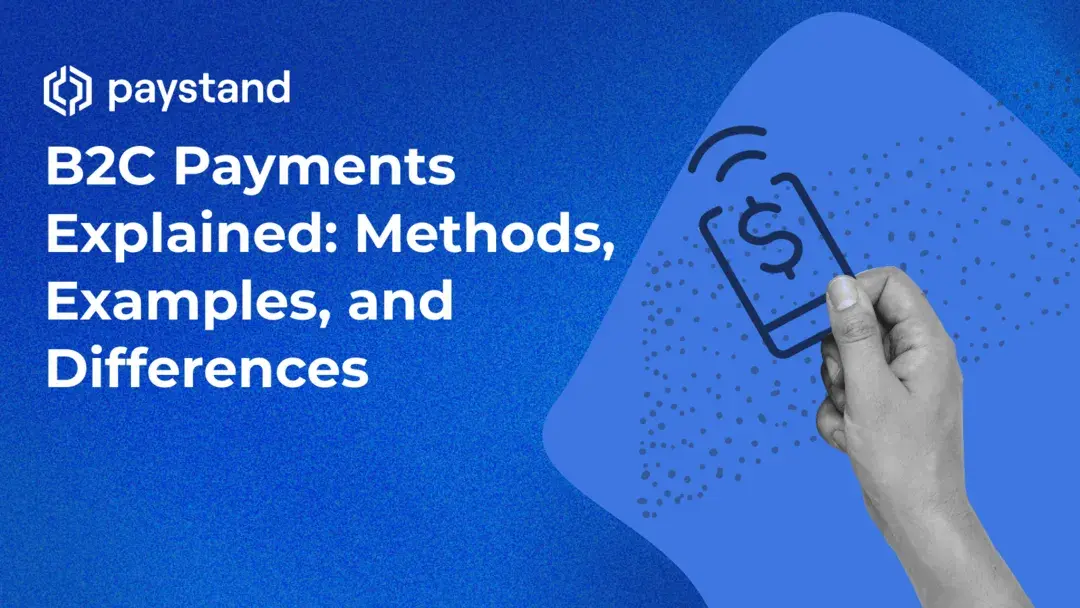B2C Payments Explained: Methods, Examples, and Differences

Table of Contents:
- What Are B2C Payments?
- B2C Payment Methods
- What is the difference between B2B and B2C billing?
- How are B2C Payments Different from B2B, C2B, or C2C Payments?
Key Takeaways:
- B2C Payments: Business-to-consumer payments, including refunds, rebates, insurance claims, and payroll.
- Methods: Commonly involve digital channels for secure, fast transactions.
- B2C vs. B2B: B2C payments are simple and immediate; B2B payments are complex, often involving custom terms.
- Payment Gateways: Facilitate secure, efficient B2C transactions via credit cards, digital wallets, and bank transfers.
- Comparison: C2B (consumer-to-business) and C2C (consumer-to-consumer) payments differ in direction and context.
- Impact: Effective B2C payments optimize business processes and enhance consumer satisfaction.
B2C payments, or business-to-consumer payments, are transactions where a business pays an individual consumer, often seen in refunds, rebates, insurance claims, and payroll. This guide breaks down the essentials of B2C payments, common methods, examples, and how they differ from B2B and other transaction types, helping businesses better understand this key payment model.
What Are B2C Payments?
B2C stands for “business-to-consumer” and refers to a business's payments to a consumer (an individual customer). Consumers who participate in B2C payments are usually people or small businesses that receive money from a company.
B2C Payment Methods
There are a few critical uses for B2C transactions. Here are the most common ones:
Refunds
Suppose a merchant makes an error or does not deliver the promised good or service to the customer in the way that it was advertised. In that case, the merchant may refund the customer by returning the funds the customer initially paid.
Refunds can benefit companies by allowing merchants to create lasting relationships and generate customer loyalty. Customers can efficiently receive their payments by issuing refunds through digital payment channels; however, some businesses still choose to issue refunds via paper check.
Rebates
A rebate is money returned to a customer after a transaction is completed. Rebates are different from discounts because, in the instance of a rebate, a consumer will pay for something in full, and then, at a later point in time, part of the full payment amount that was made will be returned to that same consumer; discounts, on the other hand, offer an opportunity for customers to purchase goods and services at a fraction of what those goods and services typically cost.
Businesses usually offer rebates as a marketing tactic: customers are drawn to deals that offer cash back on expensive items.
When a business makes a rebate payment to a customer, it is engaging in a B2C transaction. If businesses use digital channels to make rebate payments, they can also benefit from the data capabilities that result from these near-instant payments and the individually curated marketing messages that they can send along with them.
Insurance Claims
Insurance companies are businesses that cover expenses for policyholders who are owed for any damages they receive to their personal property or physical well-being during the period their insurance covers them. When insurance companies issue property or casualty claims payments to their policyholders, they make a B2C payment because the payment goes from the insurance company (the business) to a policyholder (a consumer).
Paying and Reimbursing Employees
Most businesses run payroll biweekly, meaning they have to pay their employees and contractors once every two weeks to compensate them for their contribution to the company. This is another example of a standard B2C payment: funds are moving from the business to individuals on a regular schedule, whether that’s through paper check payments, direct deposits, or some other form of digital payment.
What is the difference between B2B and B2C billing?
B2B and B2C billing differ primarily in timing, complexity, and payment methods:
- Billing Cycle: B2B payments often have longer terms (e.g., 30 days), while B2C payments happen immediately at the point of sale.
- Complexity: B2B billing involves custom pricing, contracts, and approvals. B2C billing is simpler and more direct, with fewer steps.
- Payment Methods: B2B relies on ACH, wire transfers, and purchase orders. B2C payments typically use credit cards, digital wallets, or other payment methods like PayPal.
- Relationship: B2B transactions focus on long-term contracts and recurring payments, while B2C is transactional and immediate.
What is a B2C example?
An example of a B2C transaction would be a consumer purchasing something from a company or business. Some everyday transaction examples would be your purchases at the grocery store, gas station or amazon. All of those transactions are from a business and the payment happens at the time that the exchange happens via credit or debit card, cash, check, or digital payment options.
What is a B2C Payment Gateway?
A B2C payment gateway is a secure digital service that enables businesses to process payments from individual consumers quickly and efficiently. It bridges the consumer’s payment method (credit cards, digital wallets, etc.) with the business’s bank account, ensuring fast and secure transactions.
Key Features:
- Security: Encrypts customer data to prevent fraud.
- Payment Options: Supports credit/debit cards, digital wallets, and bank transfers.
- Seamless Checkout: Provides a smooth, user-friendly experience.
A reliable B2C gateway is essential for secure, efficient transactions, enhancing customer trust and satisfaction.
How are B2C Payments Different from B2B, C2B, or C2C Payments?
B2C payments can easily be confused with other common payment types, including B2B, C2B, and C2C payments. Here is how these forms of payment differ from one another and what makes B2C payments unique:
C2B Payments
C2B is “consumer-to-business” and refers to consumer payments to companies in exchange for goods and services. An example of this kind of payment would be a consumer buying shoes from a department store or purchasing makeup from a website.
Another example of a C2B payment would be an individual purchasing a plane ticket from an airline company. In a C2B transaction, money flows from a person (the customer) to a business (the seller).
C2C Payments
C2C stands for “consumer-to-consumer” and refers to payments made from one consumer to another. For example, one individual might pay another individual back for a pizza they bought together the night before. Venmo and PayPal are examples of payment platforms that facilitate C2C transactions.
Consumers can also purchase goods from other consumers through certain platforms that facilitate resale purchases. For example, a consumer might buy a designer handbag from another consumer on eBay or a similar platform. In C2C transactions, no businesses send or receive money to consumers; the payments are solely transferred from one consumer to another (but they might go through a third-party business platform that makes the transaction possible for a fee).
B2B Payments
B2B payments, on the other hand, do not include individual people (consumers) in the payment process. They only refer to payments made from one business to another. For example, a business might need to purchase CRM software from another business.
The business that is the seller of this software will likely have a large sales team in charge of educating potential consumers about the benefits of the CRM software. This company is also likely to have a robust customer support team that can help answer any questions and solve any issues that may arise for the business acting as the customer. Customer support and sales teams work to onboard new customers and ensure they have everything they need to integrate the purchased software into their business.
B2B companies usually sell products and services to enhance essential business operations, such as accounting software, ERP payment systems, and HR software.
B2C payments play a crucial role in everyday transactions, offering businesses a streamlined way to manage refunds, rebates, insurance payouts, and payroll. Companies can optimize their payment processes and enhance consumer satisfaction by understanding the types, methods, and differences from other transaction types. For a deeper look at how digital payments can transform your operations, explore our Digital Payments in Your Supply Chain guide and discover innovative ways to stay ahead in today’s evolving payment landscape.







%20(1)%20(1).jpg?width=100&height=100&name=IMG_3752%20(1)%20(1)%20(1).jpg)